Last updated on June 13, 2022

Mascot Exhibition | Illustration by Randy Vargas
Draftsim has long catered to the nerdier side of Magic (yes that is a thing!) and I’ve always been quite proud of that fact. We’ve done this for years with various data analysis blog articles, including big studies of aggregate user data and pick orders from our draft simulator.
It seems like data analysis in Magic, particularly limited, has exploded in the public consciousness over the past year. So it was long overdue for us to step up to the plate and share some of our data from Arena Tutor with you!
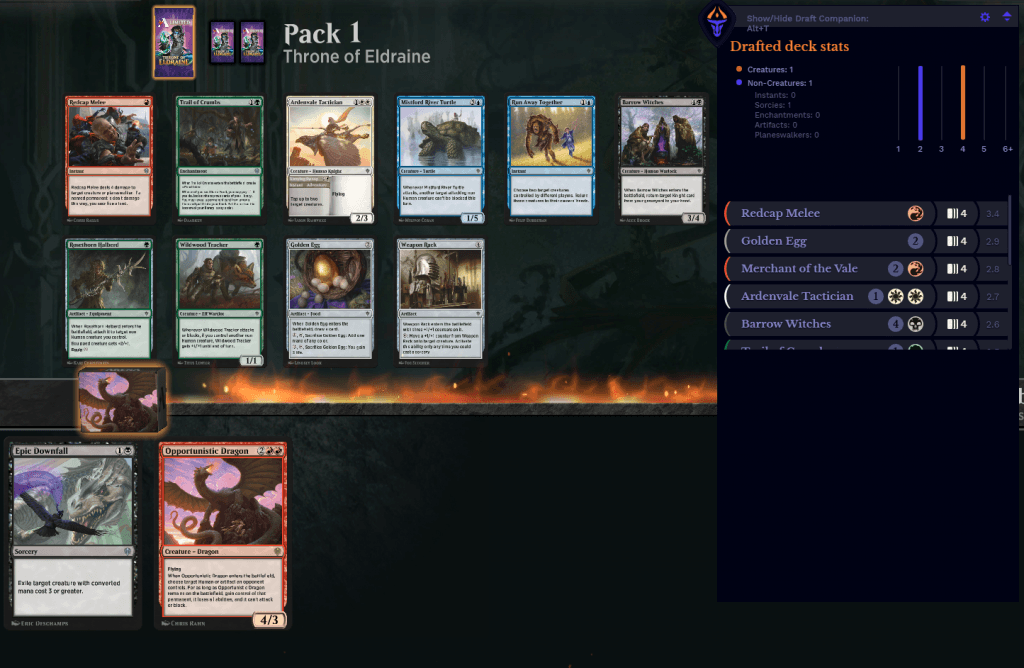
What’s Arena Tutor? It’s Draftsim’s free MTGA tracker app. You can use it while playing MTG Arena to get draft pick recommendations, see limited deck building suggestions, and to track your matches with statistics.
This is the first time we’ve ever done an analysis on the data from this application. That’s important, because unlike the draft simulator data, this dataset has actual match results that can help us understand how good various cards and decks are in a limited format.
For this project, I collaborated with Nick Tomasino, a data scientist consultant and independent contractor. When he reached out and told me he had worked on a recommender engine for mobile games at IGN, I knew I wanted to work with him. I was in!
Like me, he’s interested in draft, but he had some fresh ideas that he wanted to test out using Draftsim’s data. Thanks so much to Nick for helping with this project. It's been a blast digging so deep into Magic data!
Today we’ll look at which Strixhaven colleges and colors are the best, which individual cards are the best in each college, and even get a snapshot of the overall draft metagame.
Plus, we'll find out if vanilla Strixhaven cards better than Mystical Archive cards, or vice versa?
The Data
We took a sample of 112,000 limited Strixhaven MTGA matches on Arena Tutor through the end of April.
The data encompasses all of Strixhaven; BO1, BO3, Draft, and Sealed. While it would have been ideal to separate these out and crunch them separately, combining formats ensured that we had enough data (and time) to do certain analyses. That said, the pool of cards for each format is the same. And I think when you look at the results, they will intuitively make sense to you as well.
Our Approach
Unlike some other limited analyses that have been done, we looked at card-to-card win rates instead of single cards. This gives us much more data because we can analyze “both sides of the coin,” so to speak. We center at 50% to control for the skill level of our players.
Calculations
Essentially, all cards in a deck get a “win-point” or “loss-point” per game depending on the game result. A card must be present in a Draftsim user's main deck, or be seen in an opponent's cards played to get a point.
For AT users, this allows us to see the benefit of the effect of including the card in your deck. Not only if you drew it, and not only if you played it. Including a card in your deck has a cascading effect on your game – it changes the number and types of land you play and affects the other cards surrounding it to support its synergy. We felt like this is a good measure for “should you be drafting this card and putting it in your deck?”
Because we only have data about cards that opponents have publicly revealed (most frequently from playing the cards), we could only include that data in the overall dataset. We determined that data was still relevant and useful for the purpose of building a complete picture of the format.
Now that we've got the explanation out of the way, let's get into the meat of it!
College Comparison: Win Rate by Color Pair
Let’s start off with the thing you really wanted to know about the whole format: which college is the best? Which one stinks?
Believe it or not, the colleges seem fairly well balanced. The non-college guilds, however, fared much worse.
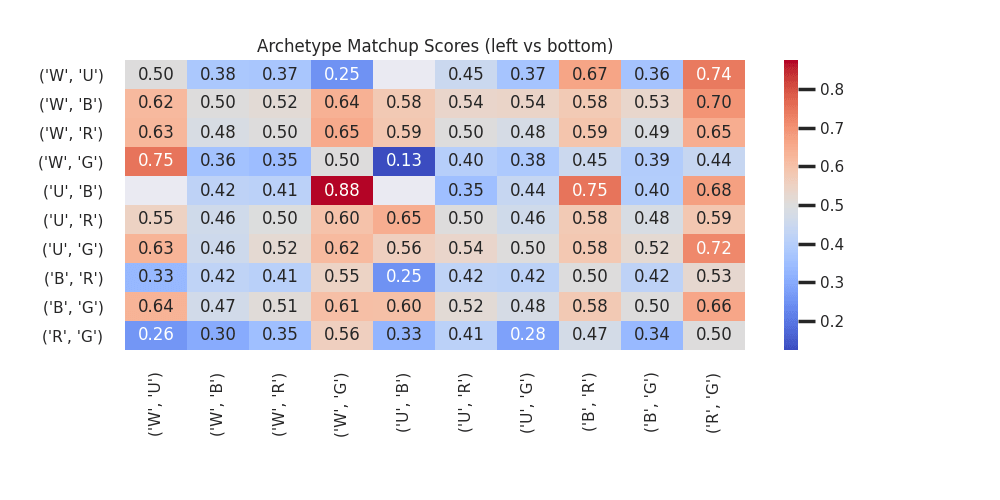
The win rate for each color pair (left) vs. an opposing color pair (bottom)
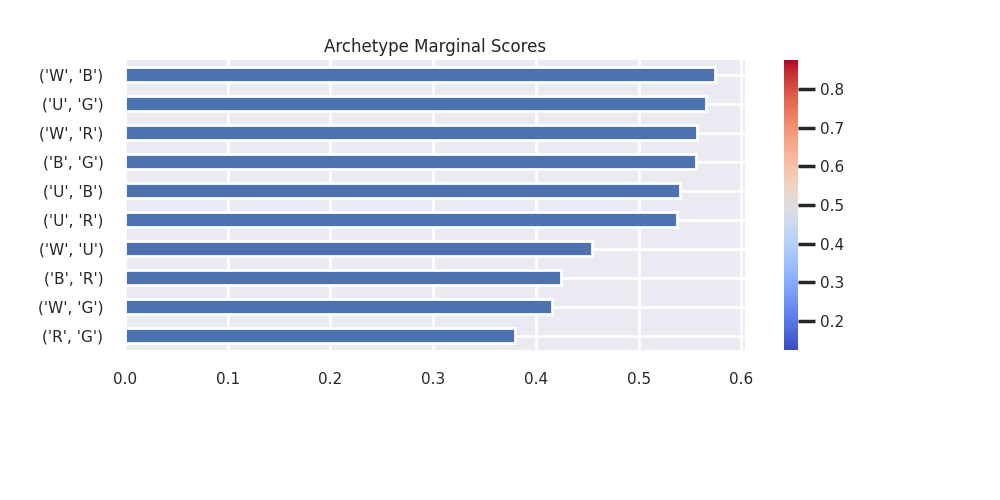
Win rate for each Strixhaven color pair ranked in order
To calculate these win rates, we looked at the colors of the top two colors represented in each deck. As I mentioned above, for opponents we looked at the color identity of cards that were played to determine their color pair. And for our users we used the color identity of cards included in the main deck.
We then counted a win for the color pair that won that game. The win rates shown are the percentage of matches won.
As you might guess, we had a lot less data for the non-college color pairs, so beware when you’re looking at those matchups and win rates and trying to make inferences.
So why's this college comparison important? It's the main dynamic of the set! You can answer questions like, “Which colleges should I prefer while drafting?” “What should I bias towards?”, and “Which colleges have the best overlap?”
To recap what's shown in the chart, the “official” college rankings here are:
- Silverquill
- Quandrix
- Lorehold
- Witherbloom
- Dimir (!)
- Prismari
But the whole range was only about five percentage points. So I think while it might be fair to express a preference for Silverquill over Prismari, the difference is not so great that I wouldn’t avoid any college as a matter of course, particularly if it’s open and the good cards are flowing.
Non-college color pairs are awful, though. Only Dimir even got to a 50% win rate. On that one, I'll leave you to Sam Black and Ryan Saxe to explain why it's surprisingly viable in Strixhaven.
The biggest college-on-college win rate disparity (“good/bad matchup”) was Prismari vs. Quandrix or Silverquill, with a 46% to 54% gap. This is not some insurmountable matchup difference, just a “clear” favoring. Again, I think this points to a mostly well-balanced format.
Silverquill's lead as the best color pair is only by a slim margin. But Prismari seems to be clearly the worst of the five colleges.
So what do I take from this? You damn well better be sure an off-college pair is really open and have some great card quality before you try going into one. Maybe slightly bias towards Silverquill or Quandrix during the draft. And slightly bias away from Prismari.
But overall, just draft what’s open because the results are so close anyway.
Best Colors in Strixhaven
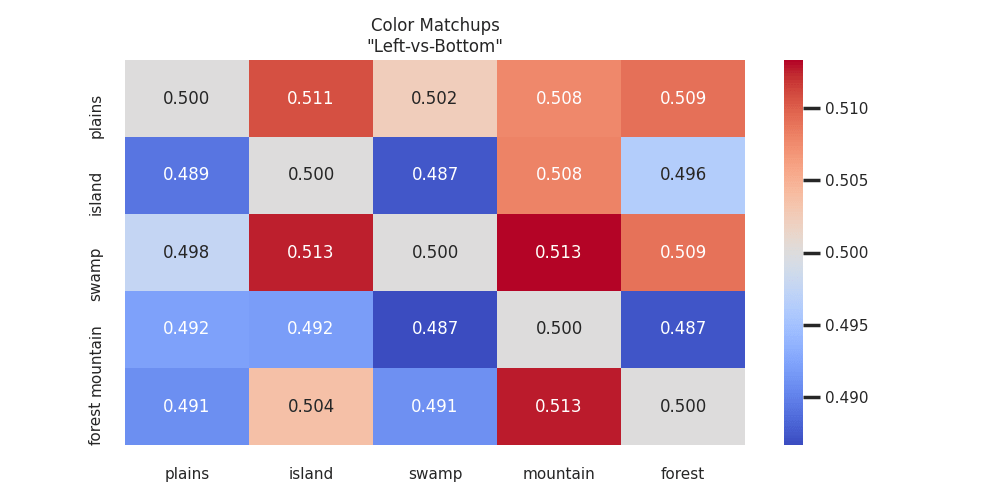
Head-to-head color matchups showing the win rate of the left color vs. the color on the bottom
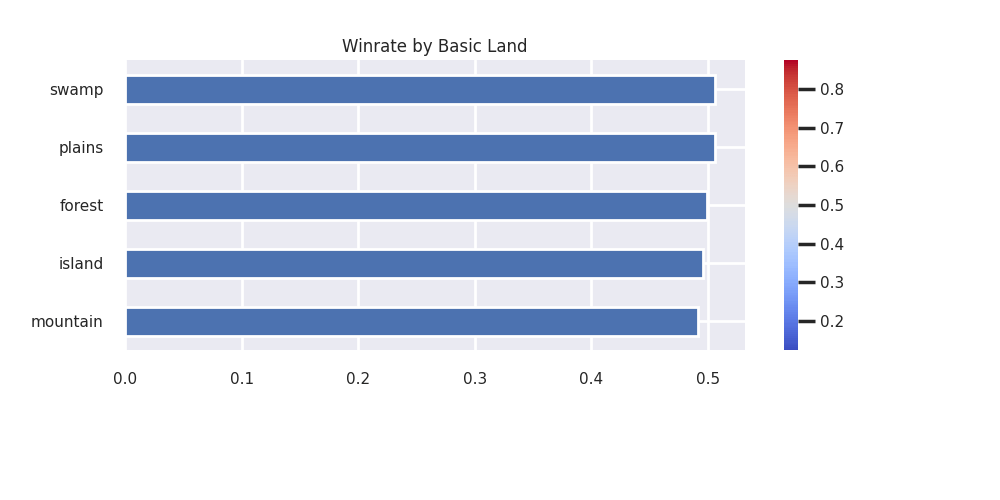
Win rate for each color in Strixhaven
At the end of the match, we added up all the basic lands played by the opponent during the game and all the lands played in the Arena Tutor user’s deck. Each land counted for the winner got one “point.” And each counted for the loser got one “loss point.”
This allowed us to get “partial votes” for splashes and also award more points for a color if it’s more heavily represented. For example, if you were playing a nearly mono-black deck, your greater percentage of swamps would give a heavier vote toward swamp when you won.
Color preference is important at the beginning of the draft. If you have a marginal decision between two close picks, you may want to bias towards the color with the higher win percentage to make it ever-so-slightly more likely you end up in a color or color pair that will win more on average.

A great card…
The rankings in the visualization above:
- Black
- White
- Green
- Blue
- Red
Unsurprisingly, this view of the data ties back to our college analysis above. We can see Silverquill's colors in first place and Prismari's in last.
Overall, having swamps and plains in your deck were the only lands/colors that would get you a better than average result.
Based on this analysis, you may also want to bias away from red during the Draft. It represents both the worst college and the third worst.
As far as the color head-to-head matchups, Swamp vs Island or Mountain and Forest vs Mountain had the biggest differentials. But at only just a 51.3% win rate, I don't think any color is too “strongly favored” anyway.
The “Metagame”: Most Played Cards
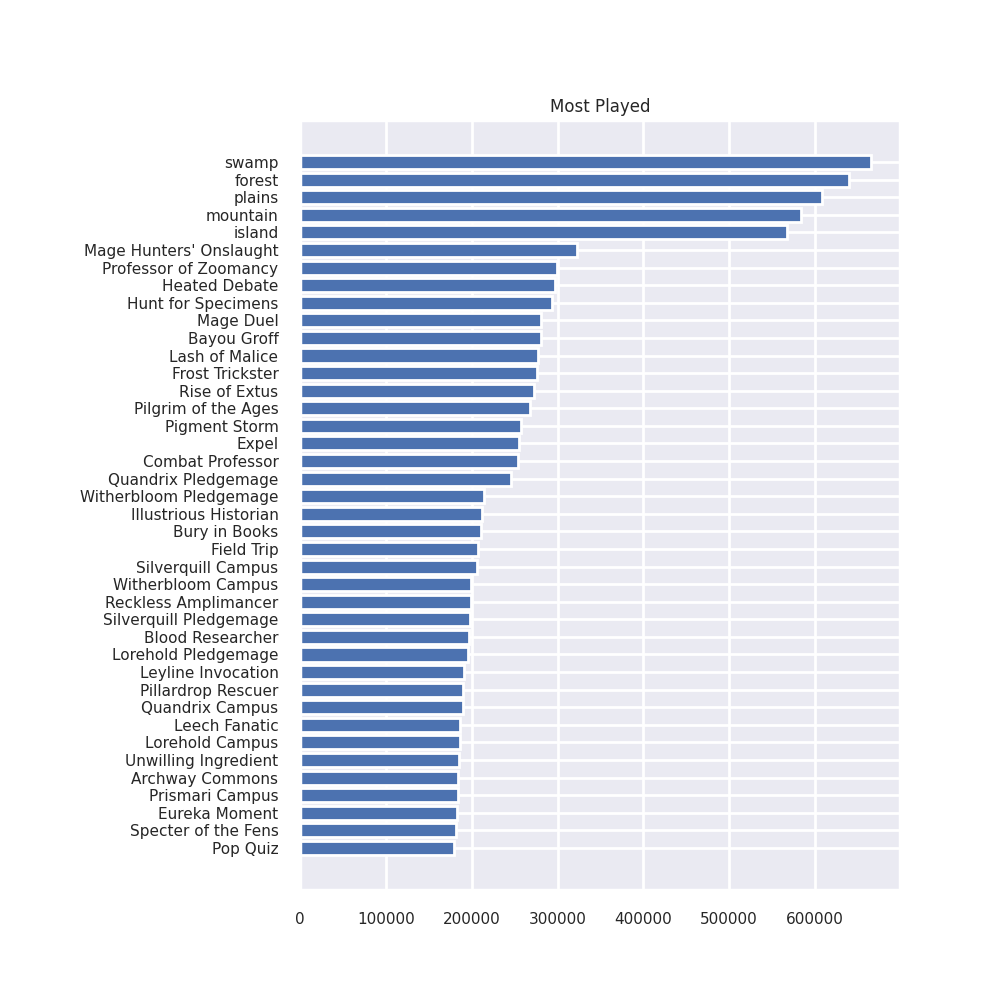
Frequency of appearance of Strixhaven cards by count
This is based on the raw count of cards seen in both user main decks and opponents cards played.
Lessons are not included because we counted main decks only for this analysis.
Obviously you get a lot of basic lands and commons here. These cards are more widely available, so barring unplayability, they're going to have the highest counts. What you end up with is essentially a list of the “most common commons.”
I think this list gives you a great idea of what to expect when you’re building your deck. What cards are the most prevalent you should expect from your opponent? You can also get an idea of which cards to play around and make gameplay or mulligan decisions about what's “more likely” to be on the other side of the table.
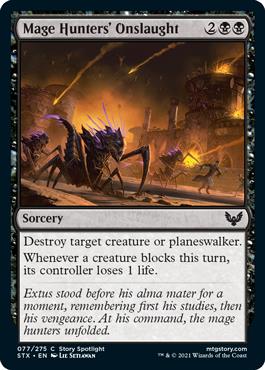
Look how popular swamp was overall! Black appears to be the most represented color in the Strixhaven metagame by quite a bit. When you look at the list of most popular non-basic land cards, there are a lot of black cards too!
Overall, these popular cards seem to generally be good ones. It makes sense that better cards see play more often. I'm also not surprised that this list is all commons, because this is a raw count.
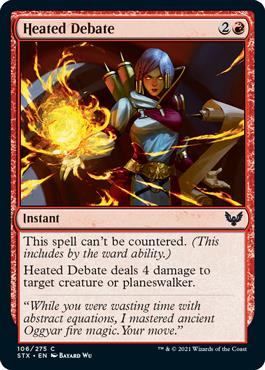
If I had to make any generalizations about this list, two things stick out to me:
- There are whole lot of learn cards. If you can’t beat card advantage some way, you’ve probably got a problem
- Silverquill Pledgemage, Combat Professor, Frost Trickster, Pillardrop Rescuer, Specter of the Fens are all on the list. That's quite a bit of flying. Maybe you should main deck that Tangletrap?

The Best Cards in Each College
To refresh your memory, this statistic takes into account when a card was seen in a user’s main deck (or was revealed by an opponent) and a win was recorded by that player.
All other things being equal, the cards below perform the best in their respective color pairs. So you should prioritize them while drafting if you don’t have a clear synergy direction or are trying to guess what the future synergy of your deck might look like.
To put it another way, these cards have the highest win rate for each college.
Prismari

Prismari cards sorted by win rate

Wow, there are a lot big spells near the top of the list! Crackle With Power, Magma Opus, Mizzix's Mastery, and Tempted by Oriq are so far out ahead of everything else.
There's a lot of learn too. Arcane Subtraction is up there with the best. Likewise Pop Quiz and Enthusiastic Study.
One surprise to me is that Rootha, Mercurial Artist had a positive win rate, but not as high as I’d have guessed. Wormhole Serpent, on the other hand, looks to be the king of the uncommon Prismari creatures, doing an impressive job pulling its weight.
Bury in Books is great and is really dominating, even beating out Lightning Bolt!
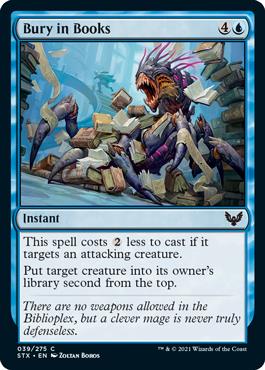
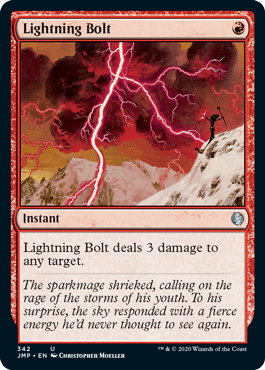
The overall texture of the list could generally be summarized as “removal and big two-for-ones/learn cards.” The creature count is pretty darn low, so it's the spells that should be drawing you into Prismari.
Silverquill
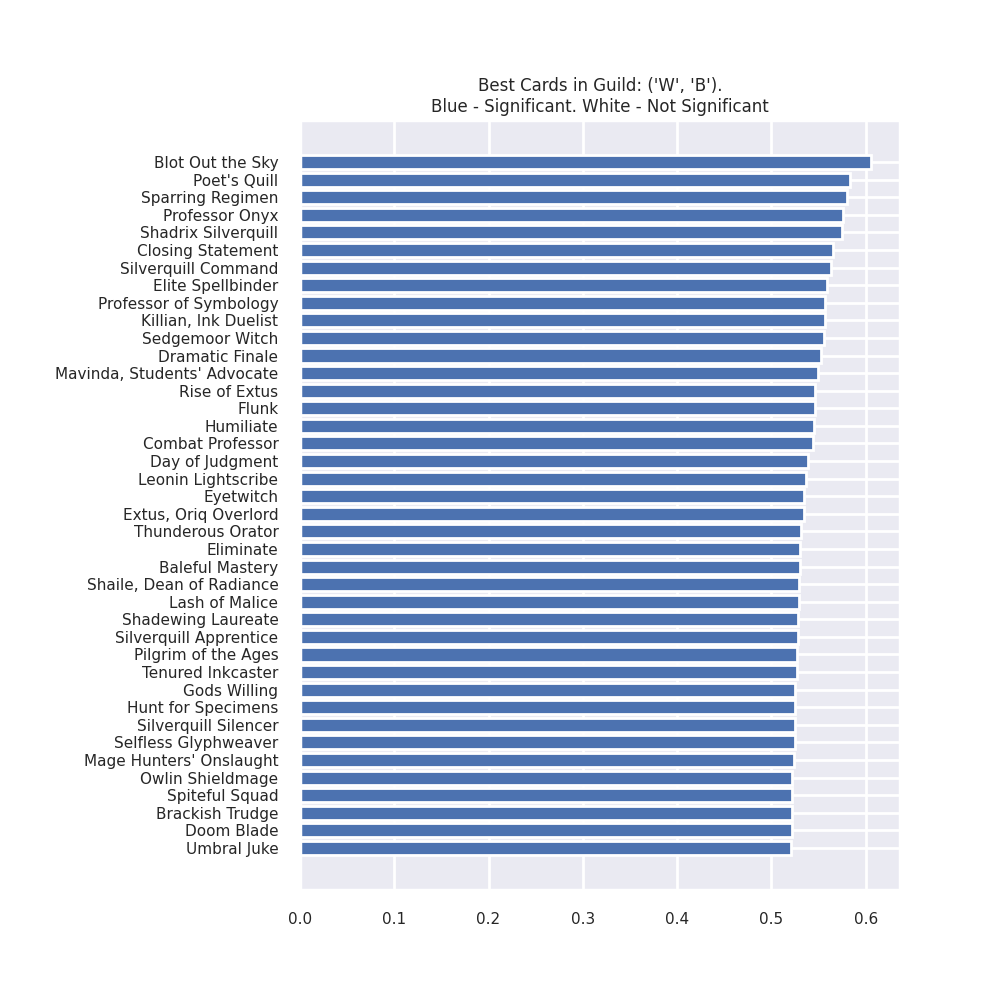
Silverquill cards by win rate
Combat Professor so high up for a common. The card is a great example of what aggressive Silverquill wants to do – evasion and pumping stuff. Clearly a pretty key card, but hopefully everyone has figured that out by now!
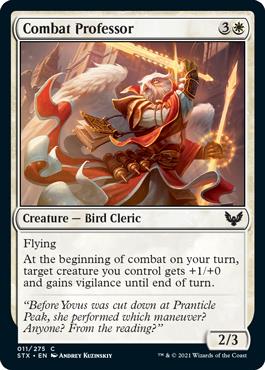
There are also a lot of amazing 2 drops on the list – Thunderous Orator, Killian, Ink Duelist, Leonin Lightscribe, and Shaile, Dean of Radiance. All of these play into the theme of Silverquill being an aggressive college, being two-drops with incredible upside/value. There are also a lot of fliers on the list too.
I was surprised to see Brackish Trudge show up on this list, though – why’s that there? Maybe Trudge plus Day of Judgement mean there are viable builds that are not completely aggro?

Lorehold
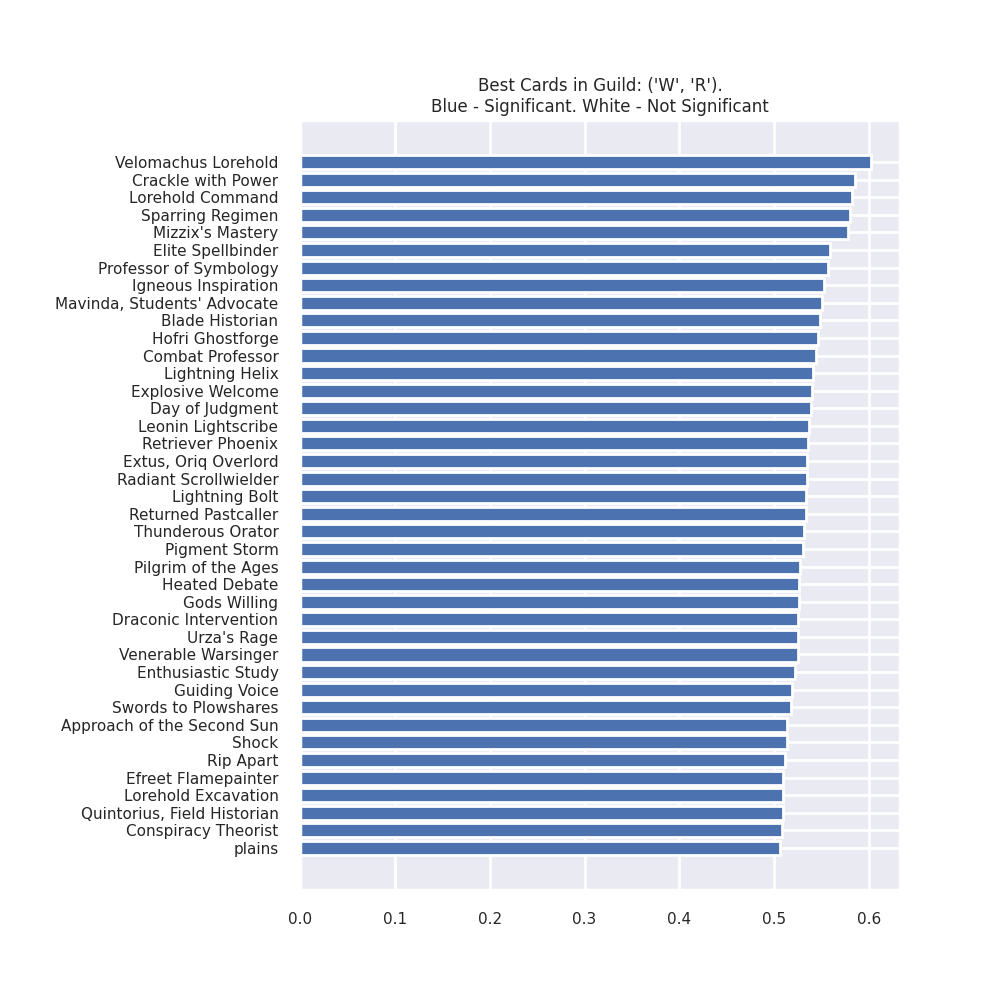
Lorehold cards by win rate
There's Combat Professor again. What a crazy card. Even Alpha mainstay Swords to Plowshares can't compete with with the prof.

Lorehold Excavation surprisingly makes it onto this list. I remember a lot of controversy at the beginning of the format about whether or not this card was any good. But it seems like if you decided to put it in your deck, you won slightly more on average than not.

But look how close to a 50% win rate the cards at the bottom of this list get vs. the previous two. I think this is why Plains is showing up as a “top card.” That means there are a lot of bad cards in Red/White that can't even muster a 50% win rate.
As you'll see in the “best cards overall” section later, there aren't a lot of great red cards on that list.
Quandrix

Quandrix cards by win rate
Wow, Bookwurm is truly a mythic uncommon. Look at that absurd win rate! It's very clearly a powerful card, but I was very surprised to see it up that high. And Bury in Books carries over its dominance from the Prismari list.

Zimone, Quandrix Prodigy got a lot of hate on social media from the limited pundits, but that card has a very comfortable win rate here. Who doesn't love drawing cards?
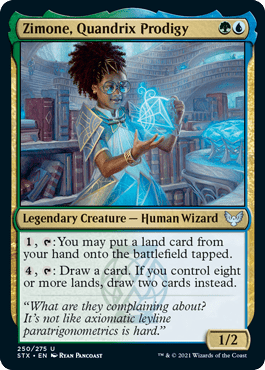
Finally, I see there is so much learn on this list. Fetching Fractal Summoning is great, isn't it?
Witherbloom
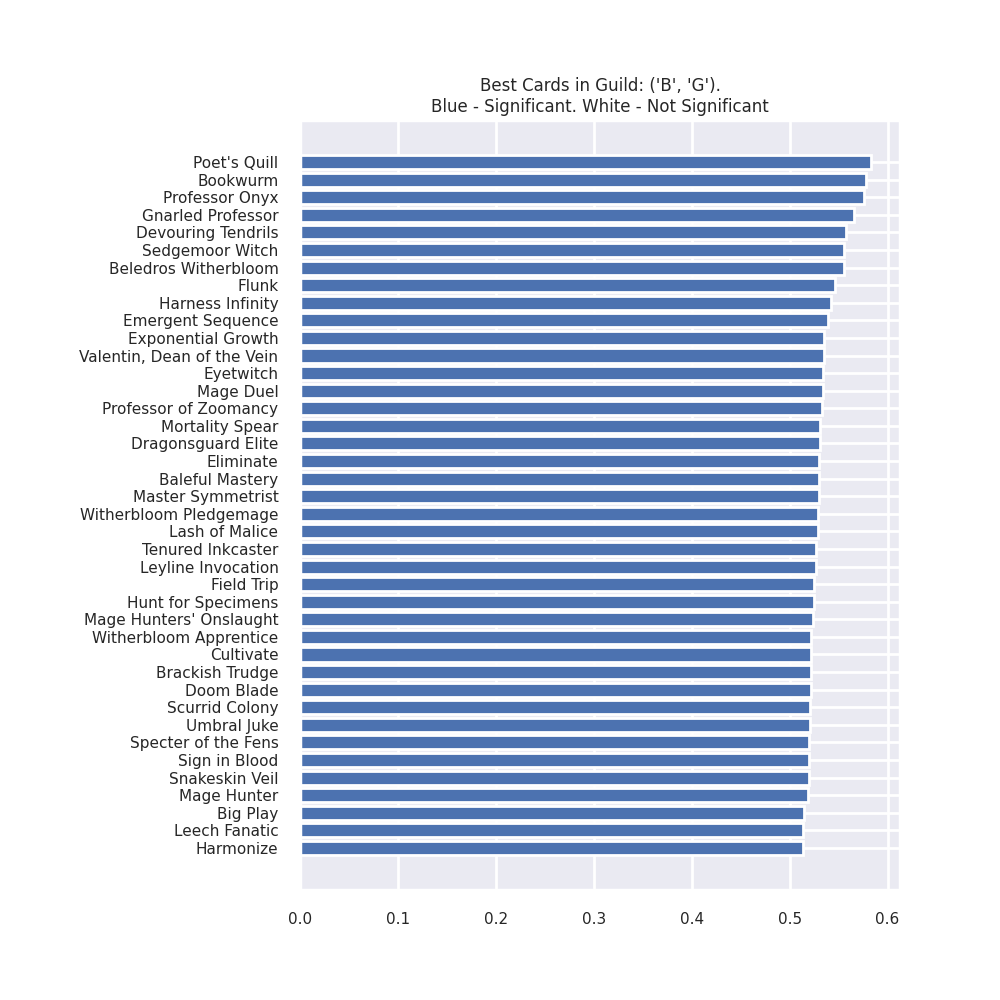
Witherbloom cards by win rate
Hmm, apparently Harness Infinity has a very high win rate. Honestly I was very surprised when the set first came out because it looked like a “too late to do anything” type of card. But it's incredibly powerful.

Exponential Growth is another one that was kind of hard to evaluate. It looks like it could be really bad. However, the data here shows that it ended up with quite a high win rate in Witherbloom.
It's fun to see Tenured Inkcaster pretty high up on the list, especially considering that you might think of it as an “aggro” card. But black/green has +1/+1 counter and lifegain synergies aplenty, so you can even have Blood Researcher pump itself!
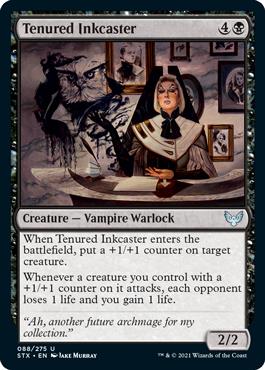
Two things that didn't sit right with me. Does Brackish Trudge really lead to more wins than Doom Blade? At least they're close. My collaborator Nick tells me not to “sludge the Trudge,” but I really don't know…
I was shocked to see Big Play on the list too.
Best Strixhaven Cards Overall
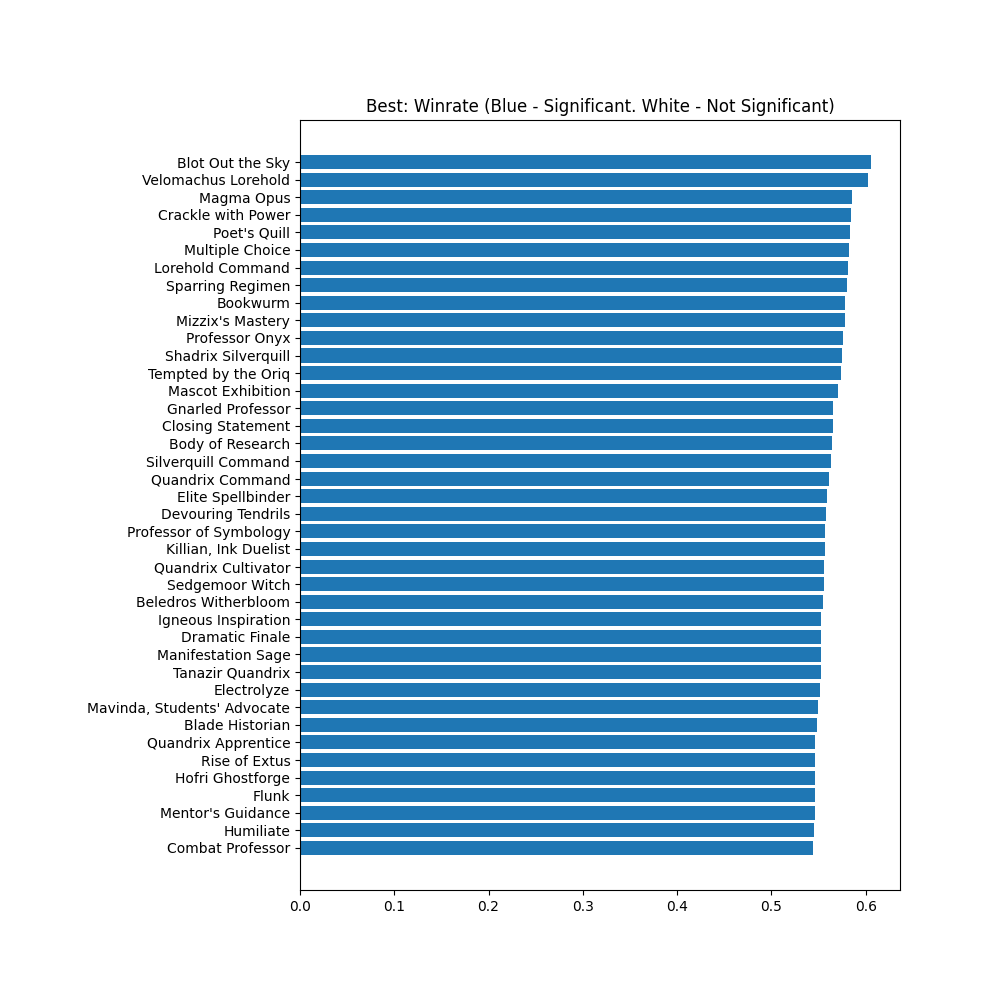
Strixhaven cards with the highest win rate
It's pretty cool to see the bombiest of bombs emerge out of this list. I don't think anything too shocking is going on. You've also got a bunch of ultra-efficient or value-granting removal spells here.
We even have a couple white powerhouse top commons in Rise of Extus and Combat Professor.

Wow, Bookwurm has the 9th highest win rate in the set!
Worst Strixhaven Cards Overall
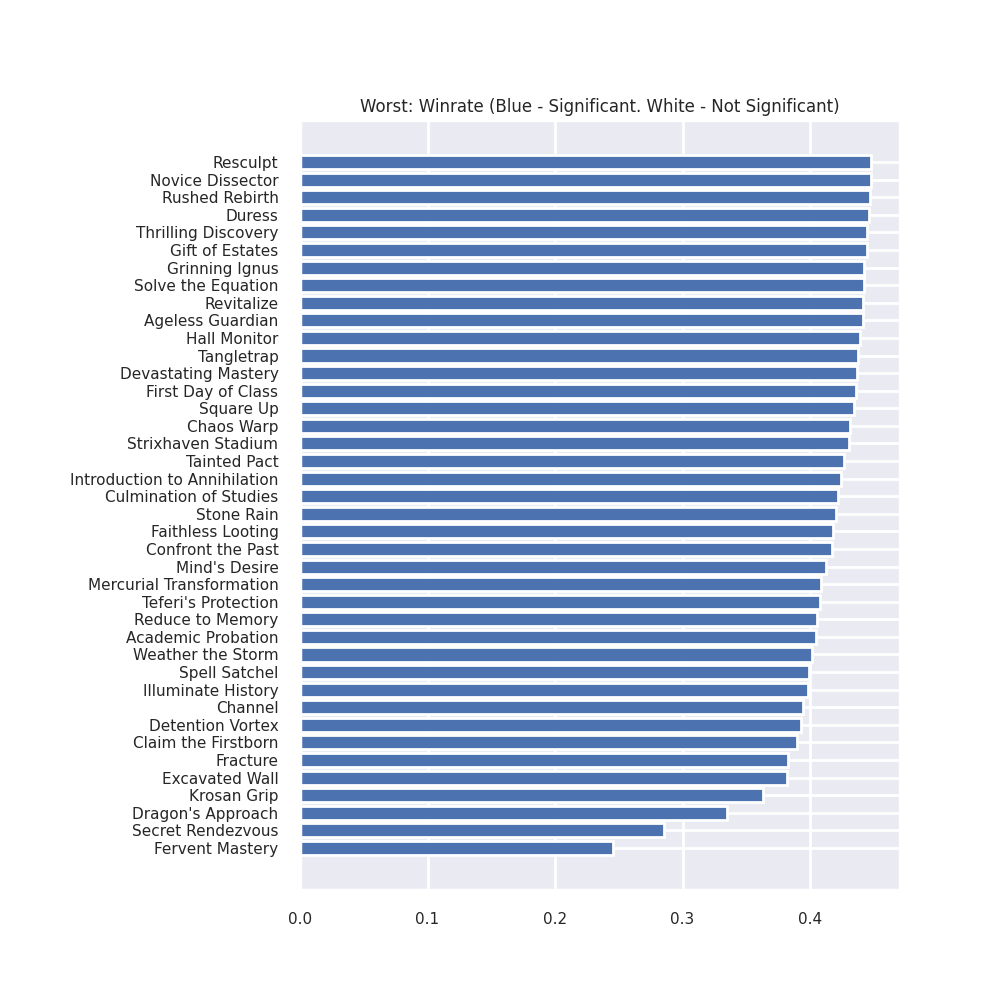
Strixhaven cards with the lowest win rate
Isn't it sad that the storm cards couldn’t get there? Maybe they would have been a better fit for Modern Horizons 2.
Honestly a lot of cards in here should be in your sideboard, particularly the ones near the bottom like Fracture and Krosan Grip.
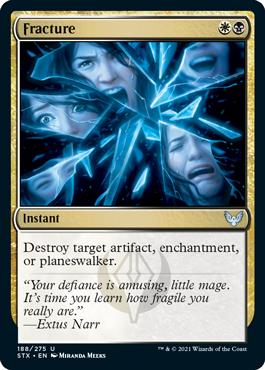
But Fervent Mastery and Dragon's Approach are truly what Andrew Cuneo likes to call “sideboard cards,” a.k.a., “cards you should put in your sideboard during a draft and never take them out.”

You’ll see Reduce to Memory and Introduction to Annihilation on this list of “bad cards,” but what's influencing this is the win rate when it was main decked. I suppose they were (incorrectly) main decked as removal-of-last-resort by some players, and they were consequently punished for playing inefficient removal spells with downside in their main decks.
Bonus: Are Old Cards a Trap??
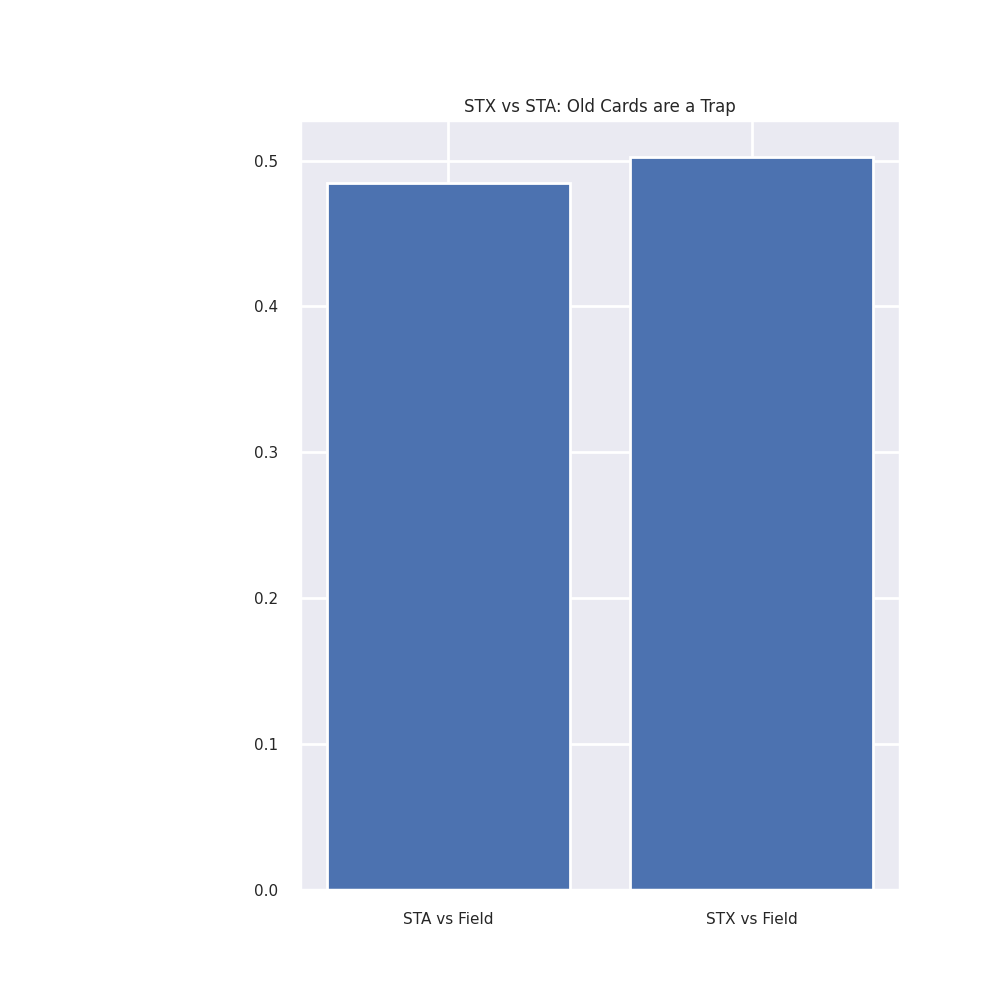
Win rates for Mystical Archive vs. Strixhaven
Like the “best cards in college” analysis, we added up all the matches each individual card won for an AT user when included in their deck, plus the cards revealed by their opponents.
But this time, we tagged each card depending on whether it was a Mystical Archive card or a “regular” Strixhaven card.
This chart summarizes two separate comparisons:
- How all Mystical Archive cards in aggregate did vs. everything (the field, both STA and STX)
- How all Strixhaven-only cards performed in aggregate vs. everything (the field, both STA and STX)
I don't think this means a ton strategically and isn't essential for understanding the format, but it sure is fun!
Obviously old cards are not a “trap,” but I think it's sad to see them getting their asses kicked by all the STX cards.
You might expect the “busted” older cards to outperform the new cards, but these were chosen pretty specifically, as were their rarities.
It's funny, but the power level of rares and even commons now is much higher than it was when some of these cards first premiered. I'd wager that accounts for some of the difference.
That said, the Mystical Archive list contains some actively bad cards like Weather the Storm and ones like Negate that are solid but aren’t world-beating.
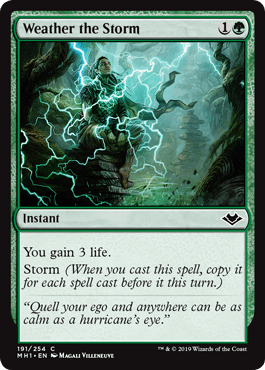
OK… and with that silly note, I think that will do it for us today.
Wrap Up
Let us know if you enjoyed this analysis! We’d love to do more in the future. What types of stuff would you like us to investigate?
If you can't get enough Strixhaven limited strategy, check out our patented Ultimate Guide to Strixhaven Draft here. It's epic, and it is an amazing overview of the format.
Finally, be sure to download and use Arena Tutor to support future articles like this. It’s completely free, so you have nothing to lose! I promise you'll love it.
Follow Draftsim for awesome articles and set updates:
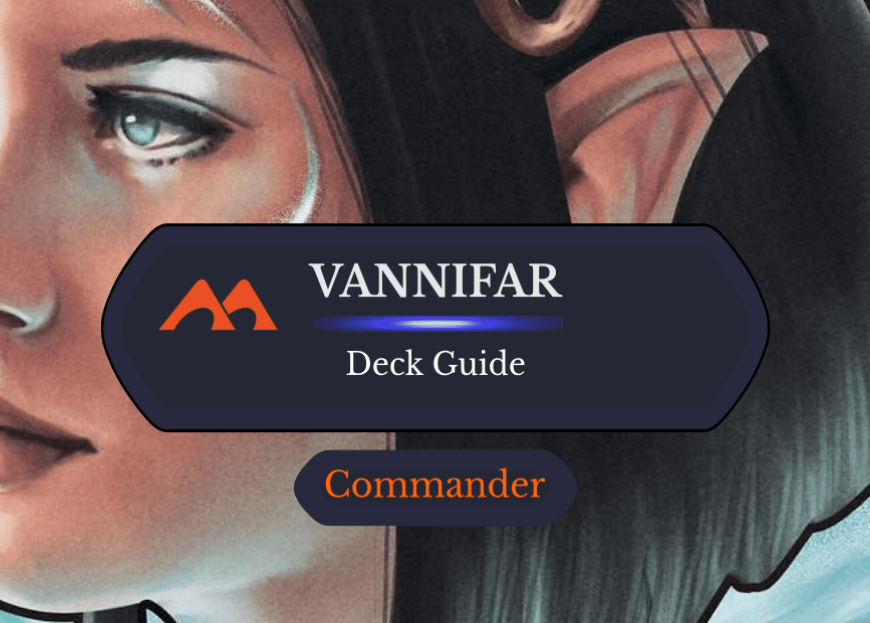
4 Comments
“A card must be present in a Draftsim user’s main deck, or be seen in an opponent’s cards played to get a point.”
This made me pause. If I understood correctly, I believe that it introduces a certain bias (in the statistical sense: the expected value of your card rating is not equal to the true value). The problem on the opponent’s side is that cards that like the game to go fast (i.e., cards whose win rate is negatively correlated with the amount of cards drawn in a game) will be deflated, and cards that like the game to long (i.e., cards whose win rate is positively correlated with the amount of cards drawn in a game) will be inflated. If the opponent is playing an extremely aggressive Silverquill deck, they will draw fewer cards on average in a game they win (therefore, those cards will collect fewer points) than if the opponent is playing a controlling Quandrix deck, where they mostly win games that go very long (plus, they have more card draw spells, draw more cards per turn on average). Therefore, Silverquill cards will get fewer win points than Quandrix cards, even at the same overall win %, simply because opponents that win will draw fewer cards on average.
I’d strongly suspect that this is why bookworm shows up so high, because that cards *really* loves when the game goes long. Not that it’s a bad card, it just might not be quite as good as the ranking suggests. This is more of an issue for the “best cards overall” ratings, not so much the within-guild ranks, because the guild controls for some of this effect (though not all: it’ll inflate Rise of Extus compared to Leonin Lightscribe in Silverquill; Professor of Zoomancy compared to Dragonsguard Elite in Witherbloom; and Wormhole Serpent compared to Heated Debate in Primary, for example).
Still a very cool analysis of course, but something to consider. Cheers!
Very interesting point, thanks! We’ll definitely have to see if that makes any difference.
This is great, Dan! Thanks to you and the others who put this together! It’s great to read articles that reflect and speak to the way I think about limited. I also appreciate the straightforward, no b.s. writing style here–it feels like a genuine conversation (unlike Magic content elsewhere, which tends to be far too up-it’s-own-end for my liking).
Thanks for the kind words! So glad you enjoyed it.
Add Comment